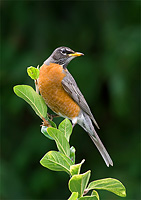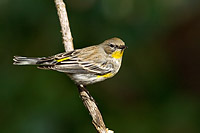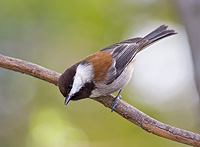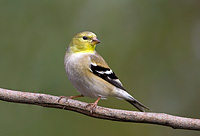Home -> Articles -> Backyard Bird Photography Tips
Backyard Bird Photography
Photography Tips and Techniques For The Birder
written by Greg Cope
Amongst the many challenging aspects of Nature Photography is the art of photographing small birds (aka Passerines). Their quick movements and shy behavior makes taking quality photographs of small birds not only difficult, but at times virtually impossible. Elements such as light, perch, pose, background: each alone is a difficult element to deal with, and all together leads to a recipe for a lot of frustration. However to get the photographic results we all wish to achieve, we do have the ability to partially intervene and control several of these elements. Rather than searching and hoping the right combination of these elements some day come together, we can bring many of these elements together by way of bird feeders. Bird feeders are not only incredibly fun to watch as well as a fun tool to use to study bird behavior, but they also yield a great way to practice bird photography. Although feeders will not attract each and every species - making it necessary for the bird photographer to still venture out into the wild - feeders will attract many common species, provide a great source to study bird behavior, provide a great location to practice bird photography, and provide a great deal of entertainment. I hope this article gives a general introduction to the common techniques to use in backyard bird photography.
~ Bird Feeders ~
Types: There is an incredible number of bird feeders out there. Platform, tube, suet, etc...and even the simplest of bird feeders: just toss some bird seed on the ground. Some feeder styles may attract different birds than others, for example a few birds may prefer a platform feeder over a tube feeder. Visit the Audubon Society or Cornell Lab of Ornithology for more information on bird feeders and their uses.
Seeds: Given the number of different types of bird food available the selection may be a little overwhelming: each type of bird food can attract different species, and some will be considerably more effective in doing so. The Audobon Society and Cornell Lab of Ornithology provides a very nice resource on seed selection: suffice it to say in my experience cheap bird seed mixes found at many stores are no way near as effective in attracting birds as Black Oil Sunflower Seeds, peanuts, or thistle. In addition to seeds, other combinations such as suet or nectar help attract a variety of birds.

American Robin waiting its turn on a backyard berry bush. No feeders or human placed perches were needed.
Locations: Bird Feeders should be positioned in a suitable and safe location, away from windows, away from locations where cats are able to access the feeder, and away from locations where squirrels (renowned for their ability to steal bird food) can pirate the food. Although not required, it is also advised to place feeders near trees and/or bushes, allowing the birds to become easily comfortable to the feeder location. Further, many species like to feed at different heights, so placing feeders at different heights may help attract different birds. With regards to bird photography, feeders should be placed in a location where there is good light during the times you wish to photograph. All this being said, birds can sometimes have a mind of their own and it may be necessary to move bird feeders around to find a location they prefer.
Plants and trees: Birds are not only attracted to bird feeders, but also a variety of plants and trees in your backyard. Not only providing shelter, plants and trees provide seeds and berries as well as more surface area for another common bird food - insects - ultimately attracting seed eating, insect eating, and fruit eating birds. The Audubon Society website provides a great description of plants and trees and species they may attract. Many of these trees, shrubs, or plants may already exists in your backyard, and many may already provide great food and great perches.
Water: Along with food, a fresh water source is helpful in attracting birds. Whether it be a fancy bird bath or simply a plate of water, doing so can help birds linger a little longer, as well as attract bird species that perhaps may not even be attracted to your feeders. It is highly recommended however, to frequently replace the water and clean the 'bath' to help prevent the spread of sickness and disease that is easily transferred through the water.
~ Perches ~
Now comes the greatest part of backyard bird photography...the perches. Natural perches (branches and twigs) rather than artificial perches (wire, tables, and fences) always make a more natural setting. Perches should be placed near the feeder in a natural position, and fewer perches increases the chances a bird will sit in the perfect position waiting to jump onto the feeder. If you wish for a clean, out of focus background, foliage behind the perch should be preferably much further than the distance between the perch and your camera location. Alternatively, nearby brush provides a nice image depicting habitat. Perches should appear natural: they should be found in the same habitat as the bird, should be placed at a similar angle as they would be on their respective tree/bush, and any pruning needed to make them look 'pretty' should be natural (no sawed off parts). Aesthetically, perch size should fit that of the birds you are photographing: you want the bird as the photographic subject, not the perch. Exchanging perches often will help avoid having several photos of several different species on an identical perch (on many occasions when I walk or hike near my house I will hunt down perches local to the area).
There are many ways to mount perches - nails, tacks, duct tape - placing them onto a fixture near the feeder. Another alternative is to purchase small piping at a hardware store that contains one or two screws on its side that can be used to hold a branch in place. Mount this to a cheap tripod with a movable head and you have an adjustable perch holder.
Many birds will still act timid toward humans, even near a feeder, thus using a blind is sometimes essential. In the case of the backyard, a house is the easiest blind imaginable. If using a house as a blind, perches and feeders should be placed within a reasonable distance to the house so your photography lens will reach, but not too close to avoid window collisions.
Lastly, perches can also serve as rudimentary feeders. Drill holes into the branch and fill the hole with seed. Use peanut butter as a 'glue' to hold seed or peanuts to the branch. And most of all be creative. (With regards to bird photography, the bird food should be placed on the opposite side of the branch relative to your direction of photography).
~ When Bird Feeders Go Bad ~
Backyard bird feeders are always enjoyable to watch and a useful tool in bird photography. But providing bird feeders in your backyard also introduces a few dangers for those birds which visit. Precautions should be made to avoid these dangers, and the Cornell Lab of Ornithology provides a nice resource for preventative measures as well as what to do in the event of a problem:
1) A rough estimation of at least 100 million birds per year are killed every year in the US from flying into windows1. Several tips to prevent these incidents are provided from the Audubon Society, including closing blinds and placing feeders away from windows.
2) Providing food for birds can result in a large number of birds in a relatively small area. So in providing food to passerines, food is also provided for birds of prey. This may present an unexpected photographic opportunity, but also make photography of the smaller birds that much harder due to their fear. In the event birds of prey begin hanging around your feeders, sometimes it may be best to remove the feeders for several weeks to let things settle down.
3) I am a cat lover, but at the same time look at them with loathing when they start lurking around my feeders. If you have cats it may be best to keep them indoors. Neighborhood cats may be more difficult to keep away from feeders, another reason to carefully place the feeders in a safe location.
4) Given the number of different birds congregating on a feeder throughout a given day, a feeder is a transfer device for the spread of sickness between birds. It is important to clean both feeders and water sources frequently to prevent the spread of sickness between birds.
~ Is backyard Bird Photography Cheating? ~
In the time I have spent "in the wild" searching for the right conditions to satisfy my yearning for the right perch, pose, background, etc....I have very few photos that I call worthy of keeping. In my time at backyard bird photography, I have had opportunities I never would have thought possible. Bird feeders are used by a great number of people, and these photography techniques used by an incredible number of Nature Photographers. Even in the somewhat controlled environment of the backyard, bird photography is still exceedingly difficult, and bird feeders provide a great way to practice: many of the photography skills learned in the backyard can be applied out in nature. When I think of those few photos I call worthy of keeping, many of those species I captured never will visit my backyard, so when it comes to satisfying a nature photographers apetite for a new shot of a unique species, backyard bird photography far from satisfies that hunger.
~ Bird Feeder Ethics ~
The ethics behind these techniques may dependent upon who you ask. Will birds become dependent upon the food? Will feeding the birds effect their behavior, mating, or migrations? Many people answer these questions with a resounding no. But as a scientist I can attest to how very difficult it would be to conclusively determine the effects bird feeders have on wildlife, and I am aware of no thorough scientific study which analyzes these affects (if you know of one, feel free to contact me with the citation). However the majority of research labs advocate the use of bird feeders and stress that the more pertinent problems feeders present are things such as window collisions and the spread of sickness. I follow the rules regarding positioning and cleaning, but even further I often try to maintain a cycle which is based upon cycles of feeding: removing or emptying my feeders for a certain period of time before I replace or refill. However, when I think of all the food provided by the trees, bushes, and grasses that 20 years ago occupied the space where my neighborhood is today, I don't feel much guilt feeding the backyard birds.
Greg Cope
Other Birding and Bird Photography Resources:
The Audubon Society - Bird Feeder tips from the Audubon Society.
What-bird - Online bird identification website.
Cornell Lab of Ornithology - An incredible resource of education, conservation, and research for birding.
Wildlife Photography by Moose Peterson - Wildlife Photography book, with a great section on backyard birding.


